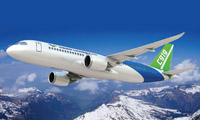Special Report: Aviation Technology
China rules: failure is not C919 option
Says China’s president, Xi Jinping.
July 1st 2014
China’s first home grown passenger jet, the 168-seat C919, is two years behind schedule and counting. But with guaranteed demand from China’s airlines and the personal backing of the nation’s leader, its success is predetermined. Read More »
While Chinese engineers have been struggling to stick to the planned schedule for development of the Commercial Aircraft Corporation of China’s (COMAC) C919 passenger jet, no-one should doubt they will get there in the end.
 |
Chinese President, Xi Jinping, has made it clear publicly that whatever difficulties come the C919, failure is not an option.
Originally, the plane’s maiden flight was scheduled for 2013. COMAC project directors said inexperience and technical obstacles meant the first flight is scheduled for next year with customer deliveries to start in 2017.
In May, president Xi visited the plant in Shanghai where the jet is being built, where he said no effort will be spared in producing a commercial passenger jet.
“In the past, someone said the best choice for us is to rent (passenger aircraft) from others and then to buy (them), and that the last option is to make our own,” he told workers at the COMAC plant.
“But we have reversed this notion. We will invest more to develop and produce our own large aircraft.” Xi inspected a demonstration prototype of the C919 and sat in the first-class cabin, looked around the cockpit and talked with several test pilots.
They briefed him on the global tour of the ARJ21, China’s smaller domestically developed regional jet. Xi told researchers and engineers the country’s aviation industry is expanding after decades of difficulty. “We have made new strides along the path of developing large aircraft. We must and we will make our own large jetliner,” he said.
COMAC needs encouragement, most particularly from the nation’s leaders. It has been learning the hard way that designing and building a passenger jet is not easy. There have been difficulties with technical aspects of the plane as well as program management and supply chain issues, which have slowed down progress.
One major setback has been the decision to use aluminium and no carbon fibre for the aircraft’s centre wing box. The change in materials was made because engineers decided it was too risky to produce the composite material locally. Manufacturing it in partnership with Western suppliers would have been too expensive.
 |
Orders for the plane, which stand at 400, have slowed, with COMAC setting a modest target of 30 new orders for this year. Not surprisingly, the vast majority of customers are from China and most of them are Mainland aircraft lessors. The only foreign buyer to date is lessor GECAS, with an order for 20. Seven Chinese airlines have ordered a total of 165.
COMAC has signed memorandums of understanding with a handful of international carriers, including British Airways IAG (International Airlines group), but these are non-binding and not guaranteed to be converted into firm orders.
Industry insiders, including executives from engine-maker CFM, which is providing the Leap-1C engines for the aircraft have said most of the problems in the program are the result of inexperience. As Chaker Chahrour, executive vice-president at CFM put it after delays in its first flight were announced: “They need really more experienced program management. They are trying to find that experience and bring it in-house.
“Building an airplane is not an easy task. It requires a lot of work with a lot of suppliers. Bringing them all to the same party at the same time has been a little bit difficult, which is why the first flight was delayed.”
In some ways the delay has better balanced the program objectives. The CFM Leap-1C engine is not scheduled to be certified until June 2015, although it is understood the Civil Aviation Administration of China may permit C919 flight testing before the engine is certified. Now, the engine development will fit better with first flight.
Nevertheless, Chahrour said the Chinese are coming up to speed tremendously fast. “It is different from the two experienced air framers, Boeing and Airbus. We have to work on the C919 program with different mindsets than we do with Boeing and Airbus, given the level of experience. But the announced dates are pretty solid. They will meet those dates. They will be flying some time in 2015.”
CFM, a joint venture between GE Aviation and Snecma has been sole supplier of engines for the B737 and more than half of the A320s in the global airline fleet. COMAC’s other non-Chinese suppliers include Honeywell, United Technologies subsidiary Goodrich, Rockwell Collins, Liebherr, Zodiac Aerospace, Meggitt, Eaton, and Parker Aerospace
COMAC has taken the sales slowdown in its stride and said it will receive more orders over the longer term from foreign customers. “Although there have not been many orders recently, we have had steady growth in orders. We have a new sales target of not fewer than 30 new orders this year,” said Dang Tiehong, deputy general manager of COMAC’s sales and marketing department.
“We have a price range in mind, although we can’t reveal it. It will give us a competitive edge over our competitors.” Thanks to lower labor costs in China, the mid-size jet will be cheaper than its western rivals, the B737 and the A320. Reportedly, an incentive for potential C919 buyers is that they do not have to put down a deposit, unlike customers of Airbus and Boeing airplanes. Price negotiations will start after the first flight of the C919.
Two months ago, the first large part of the C919, the forward fuselage, which includes the first-class cabin, rolled off the assembly line at Hongdu Aviation Industry Group in Jiangxi province and was delivered to COMAC.
It consists of more than 1,600 parts in third-generation aluminum-lithium alloy, the first time the alloy has been used in a Chinese commercial aircraft. COMAC has started production of the air frames of the first three C919s that will perform test flights. Assembly of the No.1 C919 will start by year end.
Whatever the problems, the bottom line is that the C919 is almost certain to be a commercial success in the long term, even if it is only purchased by Chinese buyers. COMAC forecasts the number of passenger aircraft in China will rise from 1,969 in 2012 to 6,494 in 2032, accounting for 17% of the global aircraft fleet. Chinese airlines and individuals are expected to purchase 5,357 aircraft, with at least 50 seats, for $647 billion in that period. With demand like that, China’s first venture into the larger aircraft sector should not fail.
| Orders | |||||||
| Customer | Order | Options | Notes | ||||
| ABC Financial Leasing | 45 | 0 | Leasing company owned by Agricultural Bank of China | ||||
| Air China | 20 | 0 | Beijing based airline | ||||
| BOC Aviation | 20 | 0 | Wholly owned by Bank of China, former leasing company of Singapore | ||||
| BOCOMM Leasing | 30 | 0 | Leasing company and unit of Shanghai based Bank of Communications | ||||
| CCB Financial Leasing | 50 | 0 | Leasing company owned by China Construction Bank and Bank of America | ||||
| CDB Leasing Company | 10 | 0 | Leasing company and unit of Beijing based China Development Bank | ||||
| China Aircraft Leasing Company (CALC) | 20 | 0 | Leasing company based in Hong Kong | ||||
| China Eastern Airlines | 20 | 0 | Shanghai based airline | ||||
| China Southern Airlines | 20 | 0 | Guangzhou based airline | ||||
| GECAS | 20 | 0 | Leasing company based in Stamford, CT and Shannon, Ireland; unit of General Electric | ||||
| Hainan Airlines | 20 | 0 | Haikou based airline under Grand China Air | ||||
| Hebei Airlines | 20 | 0 | Shijiazhuang based airline | ||||
| ICBC Leasing | 45 | 0 | Leasing company of Beijing, China based Industrial and Commercial Bank of China | ||||
| Industrial Bank Financial Leasing Co Ltd | 20 | 0 | Leasing company of Fuzhou, China based Industrial Bank Co. | ||||
| Joy Air | 20 | 0 | Xi’an based airline | ||||
| Sichuan Airlines | 20 | 0 | Chengdu based airline | ||||
| Total | 400 | 0 |